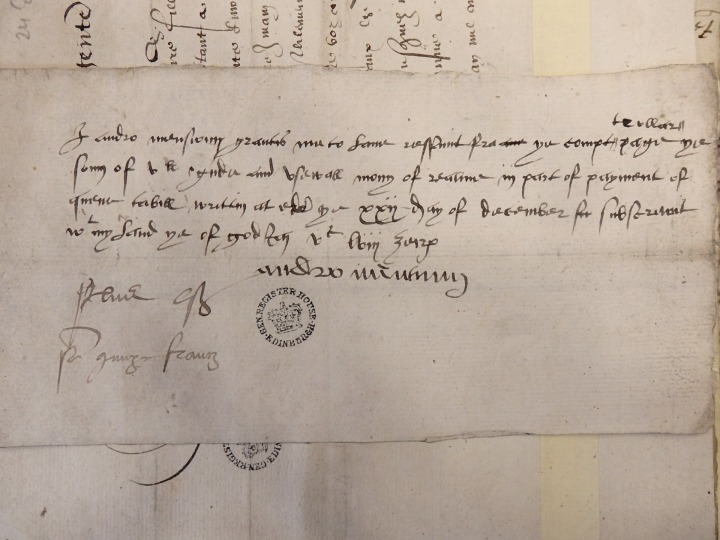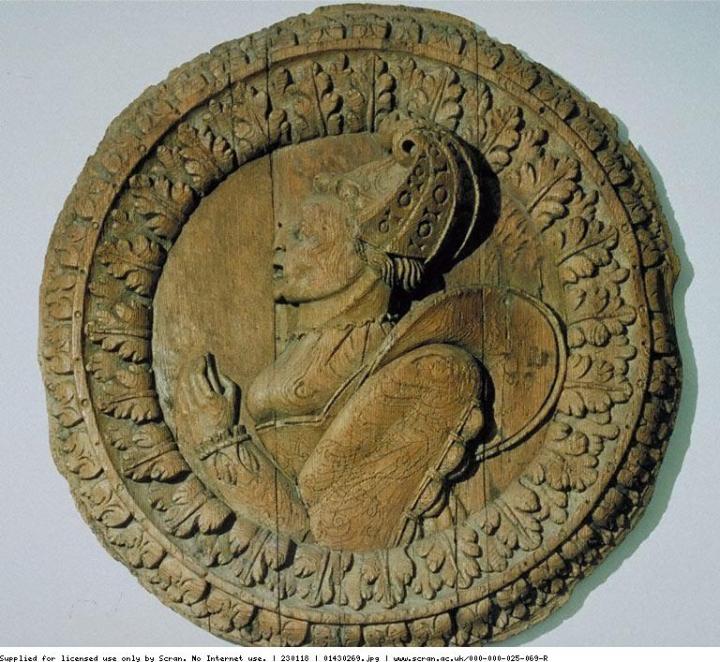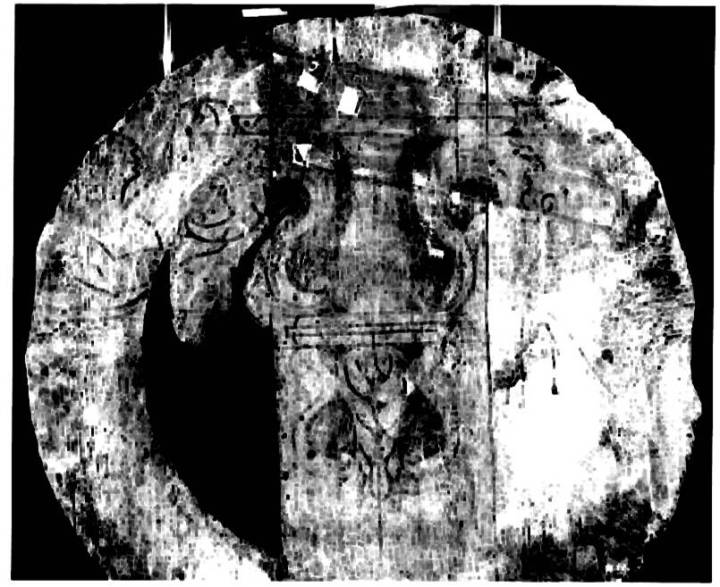Andrew Mansioun is mentioned as a French craftsman in several records from the 1530s until his death in Edinburgh in 1579. He worked on the buildings of James V and fitted out the royal ships, and made the cradle for Mary, Queen of Scots. He probably worked on the carved oak medallions for Stirling Castle known as the ‘Stirling Heads’, and one of these has a drawing on the back, which may be his.
New evidence for his life and other furniture makers in Scotland comes from the minutes of the Edinburgh Incorporation of Masons, Wrights, Painter-Glaziers and etc., which have recently come to light in the city archives, discovered by Dr Aaron Allen. Members of the craft who had served apprenticeships could become free masters of their craft, with the right to employ ‘servant’ craftsmen, make contracts and vote in the elections. The craft supervised apprenticeships and discouraged craftsmen without master status from working and trading on their own.
The minute books of the 1550s describe how aspiring wrights made an ‘assay’ a kind of master piece, of a piece of furniture. The assay was judged by four masters. The practice was different in other Scottish towns. In Perth the wright craft (which also catered for bowyers, coopers, barbers, and surgeons) did not require an assay. Entrants there were required to pay for a football match and a banquet, as was the practice of other crafts in Perth.
Some families were conspicuous in the Edinburgh craft. Amongst mid sixteenth-century surnames prominent in the minutes were members of the Fendour family, often associated with Aberdeen where John Fendour worked between 1495 and 1515 on the ceiling and stalls at St Nicholas Church and on the stalls at King’s College Chapel. Another John Fendour was active in Perth, in 1551 he took an apprentice Robert Henderson for five years during which time he would teach ‘the haill poynts of the wrycht craft without ony fraud’.[1]
Schang is another surname found in both towns, with Adam, Patrick and David in Edinburgh and in Perth, David, James, Marcus, William and Thomas Schang. In 1562 Mary Queen of Scot’s brother James, Earl of Moray, had a bed made by one ‘Schang’. The Fendours and Schangs represent both movement and settlement, an experience particularly shared with masons but perhaps less common among bakers, shoemakers or weavers.
The Edinburgh records identify some craftsmen as French in the 1550s. These include three wrights, Andrew Mansioun, Peris, and Nicholas, and a painter, Guilliam. Andrew Mansioun was still resident in Edinburgh, with an apprentice James Philp and a servant wright William Littlejohn, when he died in 1579. His sons Francis and Joshua made pulpits and beds for James VI in the 1590s. Mansioun took part in the judging of assays and it is reasonable to think of a French School of furniture making in Edinburgh.
Mansioun was a master of several trades. The first notice of ‘Andro’ is at Holyroodhouse in 1535, working on the building or its interior fittings. In subsequent years other French craftsmen arrived in the service of Mary of Guise, the bride of James V. As a wright with the royal artillery Mansioun built stocks and cranes for moving guns and heavy weights, and with colleagues also made fittings and furniture, including ‘chambers and carved work’ for the king and queen’s boat. The chambers in the boats which took James V and Mary of Guise for short journeys on the Forth between Edinburgh and Stirling were presumably complete panelled rooms with integral furniture.
In 1540 Andrew made a cradle for Prince James. He carved wooden moulds for the badges on bronze guns made in Edinburgh and assisted with the casting of guns. In March 1542 he engraved the Royal arms, unicorns, thistles and fleurs-de-lys on a brass cannon.
In December 1558 he was paid £5 for work on the ‘queen’s table’, an altarpiece, framing panel paintings bought in Flanders for Mary of Guise, to be installed in the Chapel Royal at Holyrood Palace in May 1559. Another French craftsman, ‘Baratte’, requested payment for his time varnishing the altarpiece while “le tableau a este assis en la chapelle.” [2]

The records of Mansioun as a carver have led to the suggestion that he made the oak portrait medallions for the palace at Stirling Castle, now known as the ‘Stirling Heads’, as well as the later heraldic ceiling motifs at Holyroodhouse. The Stirling medallions were carved from a pack of three-deep Baltic oak planks, in some cases with the backgrounds pierced through.

In 2005 conservators documenting the carving of a woman in masque costume (head number 29) found a drawing on the back. It shows two grotesque figures holding masks and scrolls centred on a baluster, with a lower register of a leafy pendant. The drawing is in black chalk or crayon, with some incised horizontal lines, and was presumably a sketch for a carving which has not survived. This may be a drawing by Andrew Mansioun, who, as we can deduce from his work on the artillery, was a skilled draftsman.

In May 1544 Andrew hurt his hand firing cannon at the English on the Royal Mile on the day Holyroodhouse was looted. Regent Arran paid for his care, and this mishap with the hand wasn’t the end of his career.
Master Pieces: Thomas Wood & Thomas Kennedy
In September 1555 Mansioun was appointed an assay master for the Edinburgh craft. The craft minutes record two wrights’ master pieces in 1555. There were four masters to judge the ‘relevance’ and ‘sufficiency’ of the piece. The assays were an extending or drawing table with three leaves and a ‘pale’ dresser – a dresser or cupboard with a wooden canopy. Thomas Wod undertook to make the table. The action of the table was clearly described, with two leaves (lids) to be drawn out together and the upper (omest) leaf to sit down in the middle between the two that had been underneath:
The said day Thomas Wod wrycht hes taine him till ane assay viz: to mak ane drawin burde with ane close case with thre lids, that is to say baith the lidds to draw furth at anis & ye omest lid to fall doun In the midds betwix the tua undermaist, & sall fall to the samyn the morne and bide quhill it be done & thir ar his maistirs assayers viz Andro Mansioun, Jhone Stewart, Jhone Cunninghame & Jhone Mewrois.[4]
Thomas was told to set to work on this task next morning until it was complete. He had ‘servant wright’ status but was not necessarily employed by a master, and either had premises and the means to support himself while making the assay or was perhaps permitted to work in a master’s shop.
Wood became a successful master, a burgess of Edinburgh, and was deacon of the wrights in 1574 and an assay master. He was reasonably prosperous when he died in 1585 during the plague. His wife was Bessie Wallace and he had two female household servants Marion Thomson and Janet Forrest. He rented his house and premises from a merchant, Alexander Hunter, for an annual rent of £8, and rented other houses to sub-let. At his death, Bessie submitted the inventory of his workhouse stock including two long drawing tables, another table, a short form, three new almeries at £12 each, a new ‘langsadill’, a bench, at £6, another ‘humble’ langsadill at £4, seventy pieces of wainscot (oak) £1 each, deals and broken timber in the loft, and more deals in the yard, some recently bought for £3 the dozen, some cloth and £180 cash. His stock was worth about £300.
Thomas Wood may have made a number of drawing tables over his thirty years career. They don’t appear frequently described as such in Scottish inventories, but may have been described as ‘compters’. Perhaps these tables were in demand in Edinburgh for dining, in urban settings where wealthy merchants or aristocratic lodgers had no use for the whole trappings of the formal hall and ate in less spacious settings.
The other assay described in 1555 was a dresser by Thomas Kennedy. This was an elaborate decorated piece to serve as a cupboard at dinner. The vocabulary used to describe its detail is obscure. The back was ‘square’ which often means ‘proportionate’. The ‘head’ may be another word for the ‘pale’, a canopy. The rest of the description refers to broad ‘muldreis’ (mouldings) and other carving applied to the ‘hale wair’ – the whole of the piece:
The quhilk day the dekynis & maisters forsaid hes assiginit Thomas Kennedye till mak his ane assay as use is betuix this and witsonday nixt to cum, viz ane pale dressour with ane squair bak & ane heid, ye hale wair of the dressour beand fillit with muldreis brad, with [?virglare] inmait it, At the completing of the samyn the maisters hes ordanit Patrick Schang, Jhone Stewart, Thomas Lyndesay and Adam Purves for to vesye the said assay gif it be relevant or not.
The term ‘dresser’ or ‘dressoire’ is rare in Scottish inventories, as is ‘buffet’, the word ‘cupboard’ being more usual for the serving table and display shelves used at dinner. The craft’s assay piece was perhaps called a ‘dresser’ because current vocabulary was influenced by its French membership.
John Quyhtelaw (Whitelaw)
In May 1575 Andrew Mansioun and Patrick Schang declared that John Quhytelaw had failed to complete his assay, of a ‘squair dressour’. At first the craft decided that John could not become a master. He was made to swear to make only ‘lattrouns’ (table desks or lecterns), coffers, chairs, and stools in his own shop from timber he bought, and not to work in houses, except as a servant wright to a master. However, on this occasion other masters, including the Deacon of the masons, objected to the ruling, and Quhytelaw was admitted as a full master. [5]
The judgement gives some idea of what work in theory a wright who was not yet a master could undertake. The craft tried to stop servants making contracts with clients, or furniture from timber bought by a trading partner or client, aspects of the craft reserved for full masters.
Conclusion
In Edinburgh, wrights made assay pieces of tables or dressers to become free masters of the craft. The French maker Andrew Mansioun was assay master in Edinburgh for twenty years 1555 – 1575. The craft allowed unfree wrights to make furniture, but not to contract for joinery in houses. Many of the surviving pieces and fragments of decorative panelling from Scotland are executed in French renaissance style and were almost certainly made by craftsmen influenced by Mansioun and his circle. The Edinburgh craft was open to immigrant craftsman in the 1550s and French workers not recorded elsewhere were members. However, in contrast, immigrant portrait painters with court patronage, like Arnold Bronckhorst and Adrian Vanson, did not join the craft.
Michael Pearce.
This post describes research presented at a Regional Furniture Society seminar at the V&A, ‘New thinking about 16th-century furniture’, 24 February 2018, and published as, ‘A French Furniture Maker and the ‘Courtly Style’ in Sixteenth-Century Scotland’, Regional Furniture, 32 (2018).
[1] National Library of Scotland MS 19288 Perth wrights minute book 1519-1621, fols. f9r., f13r., f20r., f24v., f27v., f67v., f69r. This original minute book includes payments for the Craft play.
[2] National Records of Scotland, NRS E25/1 nos. 9, 12, 34.
[3] National Records of Scotland, NRS E25/1 nos. 9, 12, 34.
[4] Edinburgh City Archives, Craft minutes, B2, Minutes 1555, f6v-7r.
[5] ECA, Crafts minutes B5 1574-1583, f6r-7r.